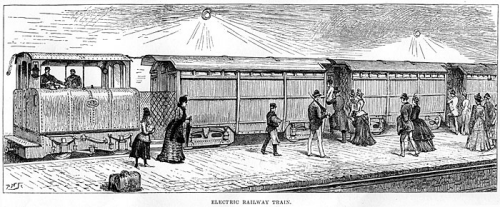Tomorrow (18th Dec) will be the birthday of the first commercially successful deep level electric railway – the City & South London Railway (C&SLR), which ran from Stockwell in South London to the City at King William Street via a tunnel under the Thames.
The railway was opened to the general public on 18th December 1890 – although the formal opening by the Edward, Prince of Wales (later Edward VII) was on the 4th Nov that same year.
Technically, it wasn’t the first deep level railway in London – as the Tower Subway had originally been a train service, albeit with just one carriage – and the Whitehall and Waterloo railway was part built as a mixture of tube and cut/cover tunneling. However, the W&W Railway never completed construction and the Tower Subway quickly abandoned its railway carriage and converted to a foot tunnel as more people could use it (and pay!) that way.
Like the Tower Subway, the C&SLR was due to use a cable based method of pulling trains along the tunnels. This is not surprising as the lead engineer on both projects was the same man – a James Greathead who had invented the tunneling shield used to manually dig the tunnels safely. However, late in the construction of the tunnel network, a decision was made to abandon the cable pull method in favour of the new modern electric locomotive. This was a separate engine unit which pulled carriages along behind it.
While this decision sounds wise – and indeed, did significantly increase the carrying capacity on the tube service – it had a fatal flaw. The tunnel approach to the terminus at King William Street was very curved and steep – which was not a problem for a cable pulling carriages along – but was almost too steep for the electric locomotive to climb up. Indeed, there are stories that sometimes a train would get part the way up the slope then have to slide back and make another run at it to build up enough momentum to get to the top.
Because of this – and due to expansions of the later tube network in general – the King William Street station was abandoned just ten years later when an extension was built up to Islington. In fact, the problems with the station had become apparent almost immediately, and plans to abandoned the station were proposed within a year of its opening, although it ended up taking 10 years to finally get rid of it.
I said earlier that this was the first “commercially successful” deep level electric railway – but it was barely profitable in fact. The extensions sapped the company of money to return to its investors and being a new form of tunneling lead to some wastage – such as the above mentioned King William Street station.
In the London Transport Museum is an exhibit of one of the original carriages for passengers – which were notable for not having any windows. The logic being quite sensible – you are in a tunnel so what is there to look at. However, we humans can be very odd creatures at times, and the carriages caused a claustrophobia and panic attacks in their passengers and small windows were later added. Having sat in the carriage, I can understand how oppressive it felt – although I think that modern bright lighting as opposed to the few tiny light bulbs used originally would significantly offset that problem.
The image below – taken from the Illustrated London News shows the carriages – and you can just about make out the tiny window slots which lined the top of the carriages but frankly offered no relief from the claustrophobic feeling of sitting inside the wooden box.

Anyhow – happy birthday to an original part of the “tube” network.
A (very large) image of the original tube layout can be found on my flickr account.






